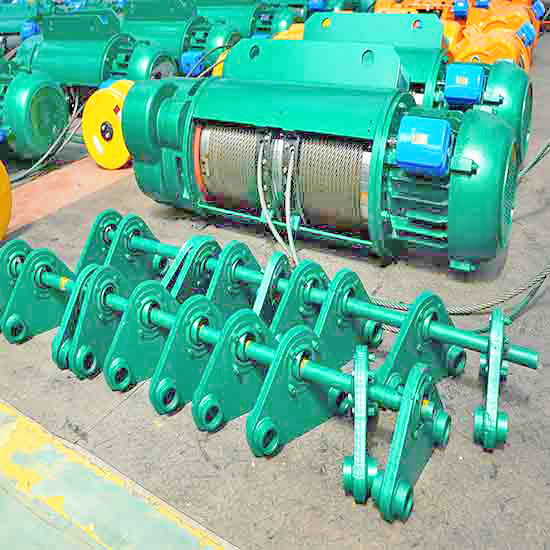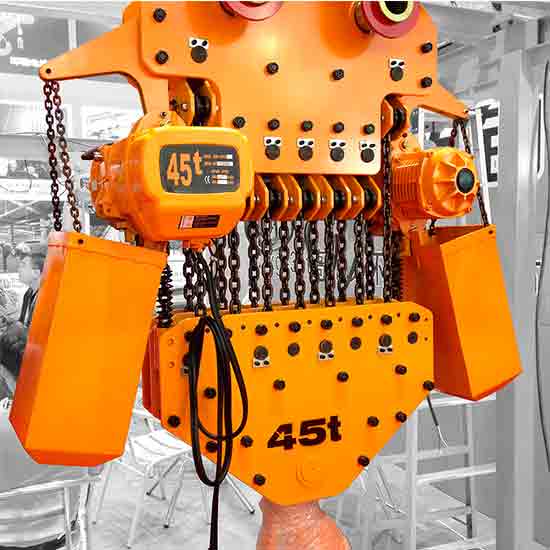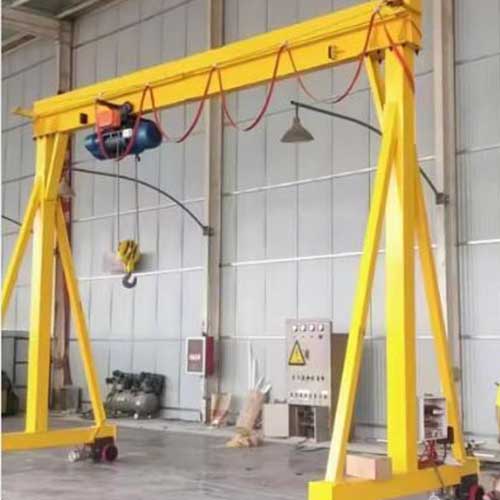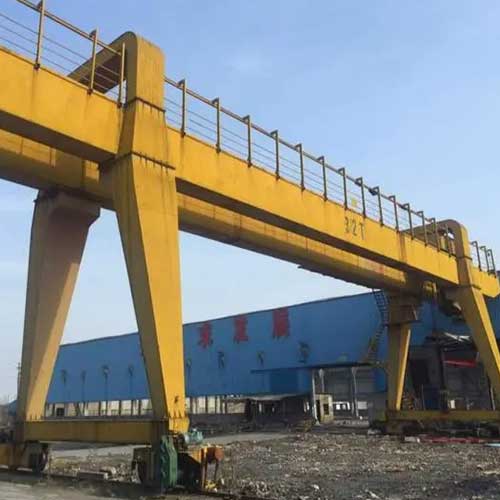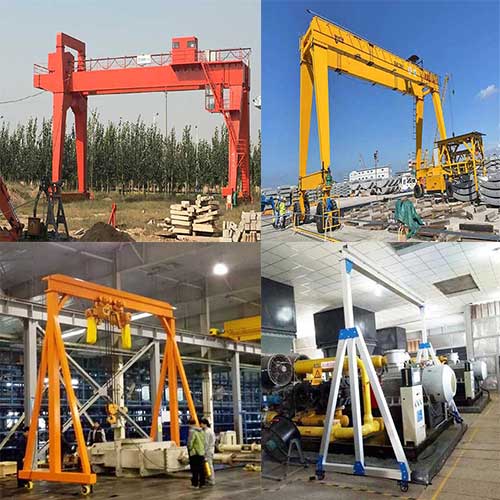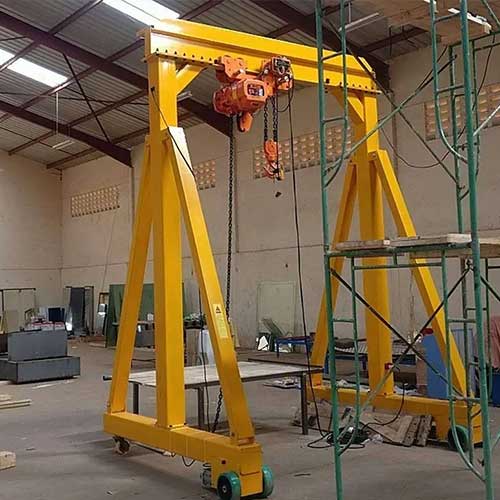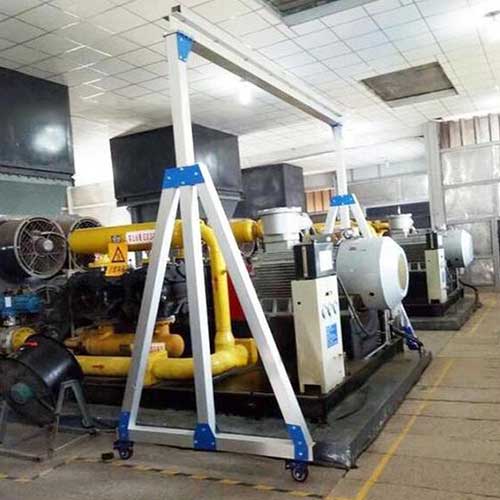A Frame Cranes for Sale: Choose Right Solution for Your Needs
All types of A Frame crane for sale. Single & double girder a frame gantry, box girder & truss girder a frame cranes, Portable steel & Aluminium a frame gantry crane.
Category: A Frame Crane
Your Trusted A Frame Crane Manufacturer & Supplier
A Frame Cranes for Sale, Choose Right Solution for Your Needs
All Types of A Frame Crane for Sale 500kg to 10 Ton, 1 T to 20 Ton, 3 T to 100 Ton
All types of A Frame crane for sale. Single & double girder a frame gantry, box girder & truss girder a frame cranes, Portable steel & Aluminium a frame gantry crane.
A Frame Cranes for Sale: Guide to Choose the Right Solution for Your Needs
Welcome to the realm of A Frame Cranes, where precision meets power in material handling solutions. A Frame Cranes, also known as A Frame Gantry Cranes, are versatile lifting systems designed for various industrial applications. Comprising a horizontal beam (the A frame) supported by two legs, these cranes offer stability and flexibility in moving heavy loads within a defined workspace.
A Frame Cranes come in different configurations, each tailored to meet specific needs. From single girder setups suitable for lighter loads to double girder structures for heavier lifting, and even portable options for on the go applications, the world of A Frame Cranes holds a solution for every requirement.
Selecting the appropriate A Frame Crane is a critical decision that directly impacts operational efficiency, safety, and overall project success. The right crane ensures smooth material handling processes, minimizes downtime, and enhances workplace safety.
Considering factors such as load capacity, span, and hoisting mechanism is crucial in meeting the demands of specific applications. A well chosen A Frame Crane not only improves productivity but also contributes to a safer working environment, preventing accidents and ensuring the longevity of the equipment.
Types of A Frame Cranes for Sale
A Frame Cranes, versatile and efficient lifting solutions, have become indispensable in various industries, revolutionizing material handling processes. Available for sale in today's market, A Frame Cranes come in diverse configurations to meet the specific needs of different applications. These cranes derive their name from their distinctive A shaped frame, which provides stability and strength, allowing for precise and controlled lifting of heavy loads. Whether it's the robust Single Girder A Frame Cranes suitable for diverse indoor and outdoor applications or the high capacity Double Girder A Frame Cranes ideal for heavy duty tasks, the market offers a wide range of options tailored to varying requirements. Additionally, the availability of Single Leg A Frame Cranes, including the innovative semi gantry designs, adds further versatility to the market, catering to those with limited space. Moreover, the advent of Portable A Frame Cranes, featuring steel and aluminum constructions, highlights the industry's commitment to providing flexible and mobile solutions for dynamic work environments. As buyers navigate the market, considerations such as load capacity, span and height requirements, and the choice between electric and manual hoisting mechanisms become crucial. Ultimately, the market for A Frame Cranes reflects a commitment to innovation, customization, and efficiency, offering solutions that contribute to enhanced productivity across diverse industrial landscapes.
Single Girder A Frame Cranes
Single Girder A Frame Cranes, a staple in the realm of material handling, are characterized by their simplicity, efficiency, and versatility. The primary structure consists of a single horizontal girder supported by two legs forming an "A" shape. This design allows for optimal load distribution and ease of movement within the defined workspace.
Types of Single Girder A Frame Cranes
Box Girder Single Girder A Frame Cranes stand out for their robust and rigid structure. The box girder design imparts additional stiffness and stability, making these cranes particularly well suited for handling heavier loads. The inherent strength of the box girder configuration ensures that the crane maintains stability even when dealing with substantial weight, providing a reliable solution for applications that demand a high lifting capacity. The versatility of these cranes shines through in their adaptability to various lifting scenarios and environments, making them an ideal choice for industries with diverse material handling needs.
Characterized by a lightweight and efficient design, Truss Girder Single Beam A Frame Cranes strike a balance between strength and weight. The truss girder construction, featuring interconnected triangular elements, ensures structural integrity while minimizing overall crane weight. This design is particularly suitable for moderate lifting tasks where a lighter structure is advantageous. The lightweight nature of truss girder cranes enhances their portability, making them well suited for applications that require frequent crane movement. Whether in a workshop or construction site, the easy transportation and maneuverability of truss girder single beam cranes contribute to their versatility in dynamic work environments.
Types of Single Girder A Frame Cranes
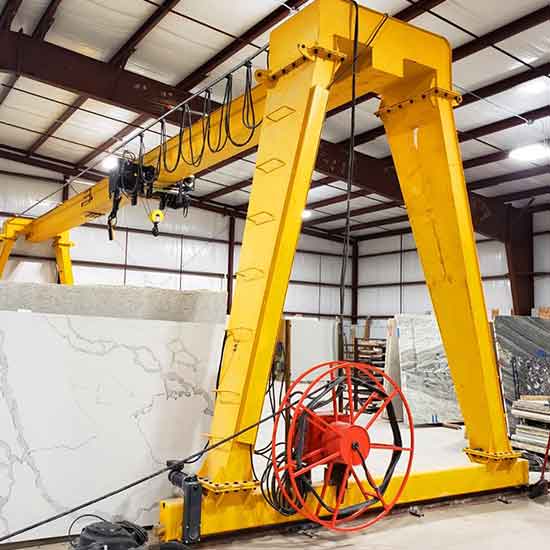
Box Girder Single Girder A Frame Cranes:
Rigid Structure: The box girder design provides added stiffness and stability, making it suitable for heavier loads.
Versatility: Adaptable to various lifting scenarios and environments.

Truss Girder Single Beam A Frame Cranes:
Lightweight Design: The truss girder construction offers a balance between strength and weight, making it suitable for moderate lifting tasks.
Easy Transportation: Well suited for applications that require the crane to be moved frequently.
Key Features of Single Girder A Frame Cranes
- Cost-Effectiveness: - Single girder A frame cranes are known for their cost-effectiveness, making them a budget-friendly choice for a wide range of applications. Their simpler design and construction contribute to a more economical solution without compromising on lifting capacity. This cost advantage makes single girder cranes an attractive option for businesses seeking efficient material handling within budget constraints.
- Compact Design: - The compact design of single girder A frame cranes is a standout feature, making them well-suited for facilities with limited space. Despite their space-efficient footprint, these cranes maintain high lifting capacities, providing an optimal solution for industries where space optimization is critical. The compact nature allows for easy integration into existing workspaces without sacrificing performance.
- Easy Maintenance: - Simplicity in design translates to easier maintenance for single girder A frame cranes. The straightforward construction of these cranes reduces the complexity of components, making inspections and repairs more accessible. This ease of maintenance contributes to reduced downtime, ensuring that the crane remains operational and productive. Lower maintenance requirements also lead to cost savings over the crane's lifespan.
In summary, the key features of single girder A frame cranes include their cost-effectiveness, compact design for space optimization, and easy maintenance. These characteristics make them a practical choice for a variety of applications, especially in industries where efficient material handling is essential while considering budget and space constraints.
Suitable Indoor and Outdoor Applications Across Various Industries
Single Girder A Frame Cranes are highly versatile lifting solutions, finding applications across diverse industries due to their adaptability. Whether utilized indoors or outdoors, these cranes excel in a range of industrial settings, providing efficient material handling solutions.
- Manufacturing:
Assembly Lines: Single Girder A Frame Cranes are ideal for manufacturing environments with assembly lines. Their precise and controlled lifting capabilities make them suitable for transporting components during the assembly process.
Material Transfer: These cranes facilitate the seamless transfer of materials within manufacturing facilities, enhancing overall production efficiency. - Warehousing:
Loading and Unloading: In warehouse environments where space is often limited, Single Girder A Frame Cranes prove efficient in loading and unloading goods. Their compact design and precise control contribute to streamlined material handling operations.
Storage Facilities: These cranes are well suited for transporting and organizing goods within storage facilities, optimizing warehouse space. - Construction: Lifting and Positioning: Single Girder A Frame Cranes exhibit versatility in construction sites, where the lifting and positioning of heavy materials are routine tasks. Their adaptability makes them valuable for various construction applications, from erecting structural components to handling equipment.
- Automotive: Handling Heavy Components: In the automotive industry, where precision is paramount, Single Girder A Frame Cranes excel in the handling of heavy components. From engine blocks to chassis elements, these cranes ensure accurate placement during the manufacturing process.
- General Industrial Applications:
Maintenance Workshops: Single Girder A Frame Cranes are commonly employed in maintenance workshops for the lifting and maneuvering of machinery and equipment.
Tool and Die Shops: In facilities where precision is critical, such as tool and die shops, these cranes assist in transporting and positioning tools and dies. - Steel and Metal Processing: Material Handling: In steel and metal processing industries, these cranes play a crucial role in the movement and positioning of raw materials and finished products.
- Paper and Pulp Industry: Efficient Handling: Single Girder A Frame Cranes are employed in the paper and pulp industry for efficient handling of heavy paper rolls and other materials used in the manufacturing process.
- Textile Industry: Material Transfer: In textile manufacturing, these cranes aid in the movement and transfer of textile rolls and machinery, ensuring smooth operations on the production floor.
In summary, Single Girder A Frame Cranes are adaptable solutions that cater to a broad spectrum of industries. Their versatility, precise control, and ability to operate in various environments make them indispensable for diverse applications, contributing to increased efficiency and productivity across different sectors.
Double Girder A Frame Cranes
Double Girder A Frame Cranes represent a robust solution for heavy duty lifting requirements. The key distinction lies in their structure, featuring two horizontal girders supported by the A shaped legs. This design imparts superior strength and stability, making them suitable for handling larger and more complex loads.
Advantages of Double Girder A Frame Cranes:
- High Load Capacity: - The dual girder configuration of A frame cranes imparts exceptional load-bearing capacity. This design enables double girder cranes to lift significantly heavier loads compared to their single girder counterparts. This advantage is particularly crucial in industries dealing with massive and bulky materials, enhancing the crane's capability to handle diverse and demanding lifting tasks.
- Extended Span: - Double girder A frame cranes are well-suited for applications requiring an extended span. The dual girder design provides structural stability, making these cranes ideal for use in large manufacturing facilities and outdoor storage yards where a longer span is necessary. This extended span capability enhances the crane's versatility, allowing it to cover larger areas efficiently.
- Height of Lift: - Double girder A frame cranes offer increased lifting height, accommodating the needs of vertical material handling. This advantage is beneficial in scenarios where lifting operations require elevated heights, such as in warehouses with multi-tiered storage systems or manufacturing processes that involve stacking materials vertically. The heightened lift capability expands the crane's range of applications and makes it suitable for diverse vertical handling requirements.
In summary, the advantages of double girder A frame cranes include their high load capacity, extended span capability, and increased height of lift. These features make double girder cranes a preferred choice for industries dealing with heavy loads and applications that demand extended reach and vertical lifting capabilities.
Types of Double Girder A Frame Gantry Cranes
Box Types Double Girder A Frame Cranes feature a sturdy and robust construction characterized by a box girder design. This design choice enhances structural integrity, providing the crane with exceptional resistance to bending and deflection. These cranes are ideal for applications that demand maximum load bearing capacity. The inherent strength of the box girder ensures that these cranes can handle heavy loads with stability and precision. Whether in heavy duty industrial settings or construction sites, the box types double girder A frame cranes offer a reliable solution for lifting tasks that require substantial weight bearing capabilities.
Truss Types Double Girder A Frame Cranes are distinguished by their lightweight design, combining strength with reduced overall weight. The truss girder structure, featuring interconnected triangular elements, provides the necessary strength for lifting tasks while minimizing the crane's weight. This makes them suitable for versatile lifting scenarios where mobility and ease of transportation are crucial. The lightweight nature of truss types double girder A frame cranes facilitates their use in applications that require frequent repositioning, providing a flexible and adaptable solution for changing work environments.
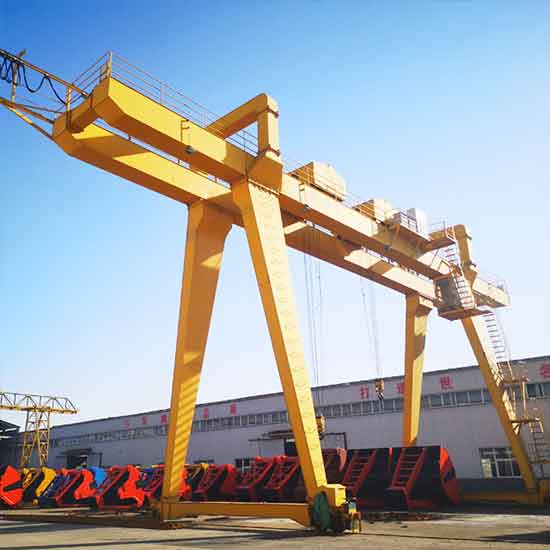
Box Types Double Girder A Frame Cranes:
Sturdy Construction: The box girder design enhances structural integrity, providing resistance to bending and deflection.
Ideal for Heavy Loads: Suited for applications demanding maximum load bearing capacity.
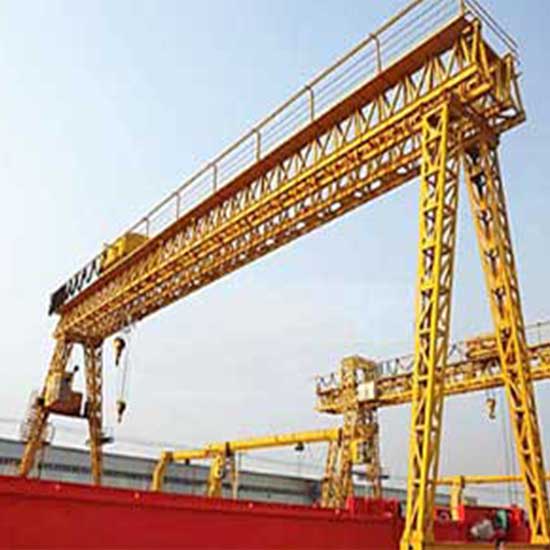
Truss Types Double Girder A Frame Cranes:
Lightweight Design: The truss girder structure balances strength with reduced weight, making it suitable for versatile lifting scenarios.
Ease of Transportation: Well suited for applications requiring mobility and frequent repositioning.
Applications and Industries Best Suited for Double Girder A Frame Gantry Cranes
Double Girder A Frame Cranes carve a niche in industries where the efficient movement and precise positioning of heavy and bulky materials are paramount. These cranes are versatile, offering robust solutions for a variety of applications across different sectors. Here are some notable applications and industries where Double Girder A Frame Gantry Cranes excel:
- Steel and Metal Fabrication: Handling Large Metal Sheets: Double Girder A Frame Cranes are instrumental in steel and metal fabrication, where large metal sheets, beams, and coils need to be lifted, transported, and precisely positioned. Their strength and precision make them essential for manufacturing processes in the metal industry.
- Shipbuilding: Maneuvering Heavy Ship Components: In the shipbuilding industry, where the assembly of massive vessels requires precision and strength, Double Girder A Frame Cranes excel in maneuvering heavy ship components and materials during the construction process. Their lifting capacity and stability contribute to the efficiency of shipbuilding operations.
- Power Plants: Lifting and Positioning Machinery: Double Girder A Frame Cranes play a crucial role in power plants, aiding in the lifting and positioning of heavy machinery and components. Their robust design and high load bearing capacity make them well suited for the demanding requirements of power generation facilities.
- Container Yards: Loading and Unloading Heavy Containers: In container yards, logistics and shipping operations demand the efficient loading and unloading of heavy containers. Double Girder A Frame Cranes provide the strength and precision required for these tasks, contributing to the smooth flow of goods in shipping and logistics.
- Automotive Manufacturing: Handling Large Automotive Components: The automotive industry, with its need for precision and efficiency, utilizes Double Girder A Frame Cranes for handling large automotive components. From chassis frames to engine assemblies, these cranes contribute to the seamless production of vehicles.
- Mining and Quarrying: Material Handling in Mining Operations: In mining and quarrying operations, where large volumes of raw materials need to be moved and processed, Double Girder A Frame Cranes offer a reliable solution for heavy duty material handling. They assist in transporting mined materials and supporting various mining processes.
- Manufacturing of Heavy Machinery: Assembly and Positioning: Industries involved in the manufacturing of heavy machinery, such as construction equipment or industrial machinery, benefit from Double Girder A Frame Cranes for the assembly and precise positioning of components.
- Heavy Equipment Maintenance Yards: Lifting and Servicing Heavy Equipment: In facilities dedicated to the maintenance and servicing of heavy equipment, Double Girder A Frame Cranes are employed for lifting and positioning machinery, facilitating efficient maintenance operations.
In summary, Double Girder A Frame Gantry Cranes are indispensable in industries where the handling of heavy and unwieldy materials demands robust lifting solutions. Their versatility and strength contribute to increased efficiency and safety in various applications, making them a key asset in heavy duty industrial settings.
Single Leg A Frame Crane
The Single Leg A Frame Crane, also known as A Frame Semi Gantry Crane, is a versatile lifting solution characterized by a single leg supporting one end of the horizontal beam, while the other end runs on a runway system attached to a wall or support structure. This unique design offers a balance between the stability of traditional gantry cranes and the space saving advantages of wall traveling cranes.
Advantages of Single Leg A Frame Cranes:
- Space Efficiency: - Single Leg A Frame Cranes excel in space efficiency, making them ideal for facilities with limited floor space. The design incorporates only one supporting leg, allowing for a compact footprint. This space-saving feature is particularly advantageous in environments where maximizing available workspace is crucial. The single-leg configuration ensures efficient material handling without compromising on lifting capabilities.
- Cost-Effective: - The design of Single Leg A Frame Cranes minimizes the need for additional support structures, leading to cost savings during installation. With only one supporting leg required, these cranes offer a cost-effective solution compared to traditional dual-leg designs. The reduced need for additional structural components contributes to the overall affordability of Single Leg A Frame Cranes, making them an economical choice for businesses looking to optimize their material handling infrastructure.
- Flexibility: - Single Leg A Frame Cranes provide flexibility in material handling operations, suitable for both outdoor and indoor applications. Their versatile design allows them to adapt to various environments, making them well-suited for dynamic workplaces with changing lifting requirements. Whether used in manufacturing facilities, outdoor storage yards, or construction sites, these cranes offer the adaptability needed for efficient material handling in diverse settings.
In summary, the advantages of Single Leg A Frame Cranes include their space efficiency, cost-effectiveness during installation, and flexibility for both outdoor and indoor applications. These features make them a practical choice for businesses seeking efficient material handling solutions in constrained spaces while optimizing installation costs.
Types of A Frame Semi Gantry Cranes
Box Types Single Leg Wall Travelling A Frame Cranes are distinguished by their rigid and stable structure, thanks to the box girder design. This design choice ensures robust stability and strength, making these cranes particularly well suited for heavy duty lifting tasks. The inherent strength of the box girder allows for the precise positioning of materials, making these cranes ideal for applications that require accurate and controlled material placement. Whether in manufacturing facilities or construction sites, box types single leg wall travelling A frame cranes offer reliability and precision in handling substantial loads.
Characterized by a lightweight construction, Truss Types Single Leg Wall Travelling A Frame Cranes strike a balance between strength and reduced weight. The truss girder structure, with its interconnected triangular elements, provides the necessary strength for lifting tasks while minimizing the overall weight of the crane. This lightweight design enhances the crane's versatility in various lifting scenarios, making it well suited for applications that demand frequent repositioning and adaptability. The mobility of truss types single leg wall travelling A frame cranes proves advantageous in dynamic work environments where flexible material handling solutions are essential.
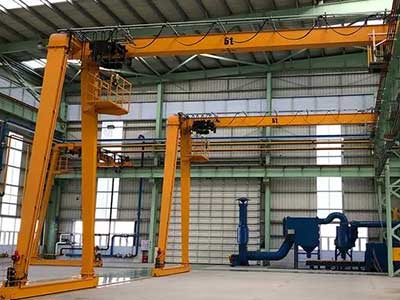
Double Girder Single Leg Wall Travelling A Frame Cranes:
Rigid Structure: The box girder design ensures stability and strength, making it suitable for heavy duty lifting.
Precise Positioning: Ideal for applications requiring precise material placement.
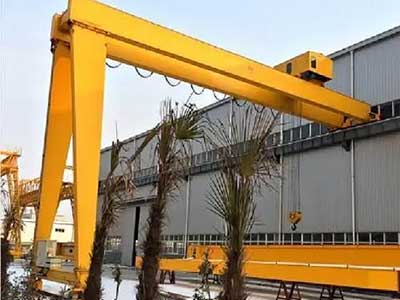
Single Girder Single Leg Wall Travelling A Frame Cranes:
Lightweight Construction: The single girder structure balances strength with reduced weight, providing versatility in lifting scenarios.
Mobility: Well suited for applications that demand frequent repositioning and adaptability.
Applications and Industries Best Suited for A Frame Semi Gantry Cranes
A Frame Semi Gantry Cranes prove to be valuable lifting solutions in industries where a balance between stability and space efficiency is critical. These cranes offer versatility and adaptability, making them well suited for various applications across different sectors. Here are notable applications and industries where A Frame Semi Gantry Cranes excel:
- Workshops and Manufacturing Facilities: Moving Heavy Materials: A Frame Semi Gantry Cranes are ideal for workshops and manufacturing facilities where the efficient movement of heavy materials and components is crucial. Their semi gantry design allows for the effective lifting and transfer of loads within confined spaces, optimizing workshop layouts.
- Construction Sites: Versatile Lifting Tasks: In construction projects where space is often at a premium, A Frame Semi Gantry Cranes showcase their versatility in handling diverse lifting tasks. These cranes can navigate construction sites, providing the lifting power needed for various materials and equipment.
- Storage Yards: Moving and Positioning Materials: A Frame Semi Gantry Cranes efficiently handle material movement and positioning in outdoor storage yards. Whether dealing with raw materials, finished products, or equipment, these cranes offer a reliable solution for optimizing storage yard operations.
- Maintenance Facilities: Handling and Servicing Equipment: Facilities dedicated to the maintenance and servicing of equipment benefit from A Frame Semi Gantry Cranes for handling and positioning heavy machinery. The semi gantry design allows for precise movements in maintenance workshops.
- Automotive Repair Shops: Lifting and Maneuvering Auto Parts: In automotive repair shops, A Frame Semi Gantry Cranes assist in lifting and maneuvering heavy auto parts. Their space efficient design is advantageous in workshops where floor space needs to be maximized.
- Outdoor Manufacturing and Fabrication: Material Handling in Open Spaces: A Frame Semi Gantry Cranes are suitable for outdoor manufacturing and fabrication processes where the lifting and movement of materials occur in open spaces. Their semi gantry configuration provides stability while accommodating the layout of outdoor work areas.
- Aerospace Industry: Handling Aircraft Components: In the aerospace industry, where precision is paramount, A Frame Semi Gantry Cranes can be utilized for handling and positioning large and heavy aircraft components during the manufacturing and assembly processes.
- Infrastructure Projects: Lifting Materials on Site: A Frame Semi Gantry Cranes are adaptable to various infrastructure projects, offering the lifting capacity needed for materials like steel beams, concrete blocks, and other construction elements.
In summary, A Frame Semi Gantry Cranes play a crucial role in industries that require a combination of stability and space efficiency. Their ability to efficiently handle lifting tasks in confined spaces makes them a valuable asset across diverse applications, contributing to enhanced productivity and safety in the workplace.
Portable A Frame Cranes
Portable A Frame Cranes redefine material handling with unparalleled mobility and adaptability. Crafted for easy relocation, these cranes are engineered to effortlessly navigate dynamic work environments. Portable A Frame Cranes are innovative lifting solutions designed for versatility and mobility in various industrial applications. These cranes feature a distinctive A-shaped frame structure, providing stability and strength while remaining easily transportable. The key advantage of these cranes lies in their ability to swiftly adapt to changing work environments, making them ideal for scenarios where on-the-go lifting is crucial.
The portable nature of these cranes allows for quick deployment to different locations, enhancing efficiency in tasks such as maintenance and repair, construction projects, event setups, and warehousing operations. Their compact design makes them suitable for workshops with limited space, and their adaptability extends to emergency response situations and temporary manufacturing setups.
With a focus on ease of transport, Portable A Frame Cranes offer flexibility in logistics, enabling rapid relocation to address evolving lifting requirements. Whether used in dynamic construction sites, bustling warehouses, or outdoor events, these cranes provide a reliable and agile solution for lifting and positioning tasks. In summary, Portable A Frame Cranes stand out as versatile, on-the-go lifting equipment, contributing to enhanced productivity and adaptability in various industrial settings.
Mobility Features of Portable A Frame Cranes:
- Compact Design: - Portable A Frame Cranes are distinguished by their compact design, featuring a space-efficient footprint. This characteristic enables seamless movement within confined spaces, making them well-suited for environments where available workspace is limited. The compact design ensures that these cranes can navigate through narrow aisles and tight quarters, allowing for efficient material handling in various settings.
- Enhanced Maneuverability: - Sturdy wheels are a key feature of Portable A Frame Cranes, facilitating smooth transportation across shop floors, construction sites, or warehouses. The enhanced maneuverability provided by these wheels allows operators to move the crane precisely to the desired location. This feature is particularly advantageous in dynamic work environments where the lifting requirements may change frequently, requiring the crane to be repositioned swiftly.
- Quick Setup: - Portable A Frame Cranes are designed for swift assembly and disassembly, minimizing downtime during relocation. The quick setup feature ensures that the crane can be easily deployed to different workstations without prolonged interruptions. This rapid assembly and disassembly process optimizes operational efficiency, allowing businesses to maximize productivity and adapt to changing lifting needs efficiently.
In summary, the mobility features of Portable A Frame Cranes include their compact design for seamless movement in confined spaces, enhanced maneuverability facilitated by sturdy wheels, and quick setup capabilities. These features collectively contribute to the agility and versatility of Portable A Frame Cranes, making them a practical choice for industries that require on-the-go lifting solutions with minimal downtime.
Steel Portable A Frame Cranes:
Steel Portable A Frame Cranes represent a robust and versatile solution for lifting needs in various industrial settings. These cranes are characterized by their A-shaped frame structure, providing stability and strength during lifting operations. Specifically crafted from durable steel materials, these cranes are engineered to handle heavy loads and withstand rigorous work environments.
The steel construction ensures the durability and longevity of Portable A Frame Cranes, making them well-suited for applications where strength and reliability are paramount. The portable design allows for easy transportation to different workstations, making them ideal for tasks such as maintenance and repair, construction projects, and material handling in warehouses.
Steel Portable A Frame Cranes offer flexibility and adaptability in logistics, proving valuable in dynamic work environments. Whether lifting heavy equipment or materials, the sturdy steel construction ensures the crane's reliability, making it a preferred choice for industries that demand robust lifting solutions.
In summary, Steel Portable A Frame Cranes combine the strength of steel construction with the portability of A frame design, providing a durable and flexible lifting solution for various industrial applications.
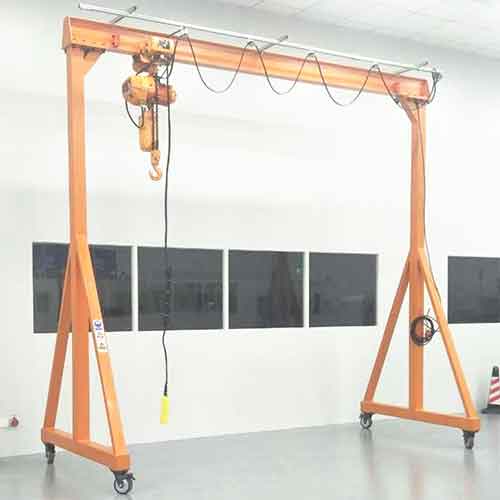
Fixed Height Steel A Frame Cranes:
Design: Robust steel construction with a fixed height ensures stability.
Typical Features: Straightforward design, making it cost effective for repetitive lifting tasks.
Benefits: Ideal for small manufacturing workshops where simplicity and reliability are key.
Typical Applications: Repetitive lifting tasks with consistent load and height requirements.
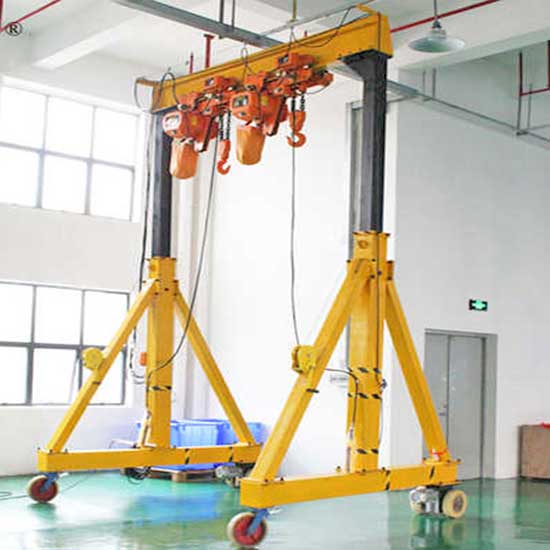
Adjustable Height Steel A Frame Cranes:
Design: Height adjustable legs for versatility in lifting requirements.
Typical Features: Flexibility in adapting to varying load and height scenarios.
Benefits: Adaptable for diverse lifting needs, suitable for workshops with varying material handling requirements.
Typical Applications: Workspaces with dynamic lifting tasks and height variations.
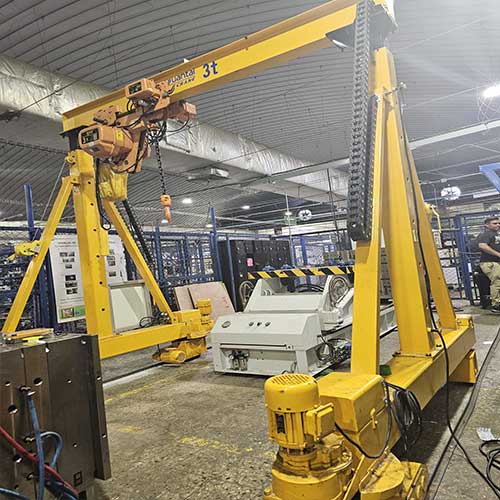
Motor Traveling Steel A Frame Cranes:
Design: Equipped with a motorized system for effortless movement.
Typical Features: Remote control functionality for convenient operation.
Benefits: Enhanced operational efficiency, making it suitable for dynamic manufacturing environments.
Typical Applications: Facilities with changing layouts and frequent crane movement requirements.
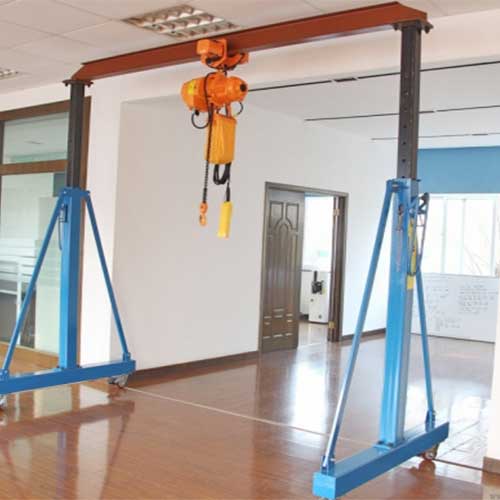
Manual Traveling Steel A Frame Cranes:
Design: Hand operated for simplicity and ease of use.
Typical Features: Manual control for basic lifting tasks, promoting user friendly operation.
Benefits: Straightforward maintenance and operation, ideal for small scale operations.
Typical Applications: Environments with limited lifting requirements and a focus on manual control.
Aluminum Portable A Frame Cranes:
Aluminum Portable A Frame Cranes are innovative lifting solutions known for their lightweight yet robust design. These cranes feature the distinctive A-shaped frame structure, combining the strength of aluminum construction with portability. The use of high-quality aluminum alloys ensures durability, corrosion resistance, and ease of maneuverability.
Designed for versatility, Aluminum Portable A Frame Cranes are suitable for a range of applications where mobility and lifting efficiency are paramount. The lightweight nature of aluminum makes these cranes easy to transport to various workstations, making them ideal for tasks such as maintenance and repair, construction projects, and material handling in warehouses.
The corrosion-resistant properties of aluminum make these cranes particularly well-suited for outdoor applications, where exposure to the elements is a consideration. Whether lifting materials in dynamic work environments or setting up temporary installations at outdoor events, Aluminum Portable A Frame Cranes offer a reliable and agile lifting solution.
In summary, Aluminum Portable A Frame Cranes combine the advantages of aluminum's lightweight properties with the A frame design, providing a durable, corrosion-resistant, and easily transportable solution for lifting needs in diverse industrial settings.
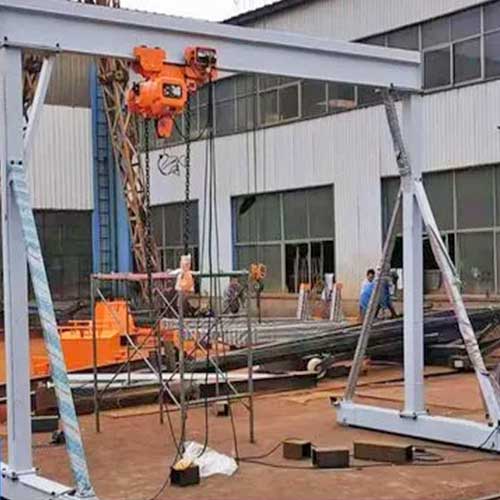
Fixed Height Aluminum A Frame Cranes:
Design: Lightweight aluminum construction with a fixed height ensures easy transportability.
Typical Features: Portable and easy to move, making it suitable for scenarios with weight restrictions.
Benefits: Ideal for lifting lighter loads and environments with strict weight limitations.
Typical Applications: Laboratories or settings where lightweight lifting is crucial.
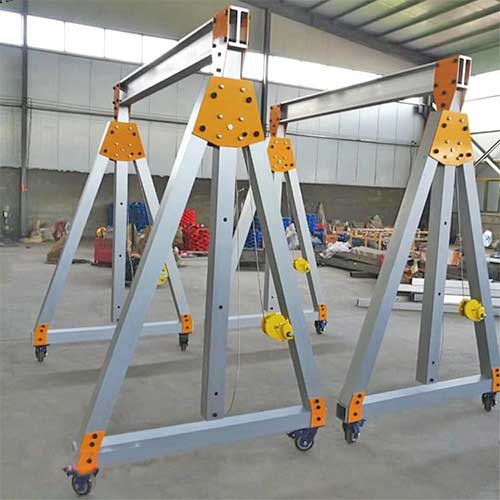
Adjustable Height Aluminum A Frame Cranes:
Design: Height adjustable for increased flexibility.
Typical Features: Lightweight construction and easy transportability.
Benefits: Versatile for different lifting heights and loads, suitable for varied lifting tasks.
Typical Applications: Environments with changing lifting requirements and adaptable height needs.
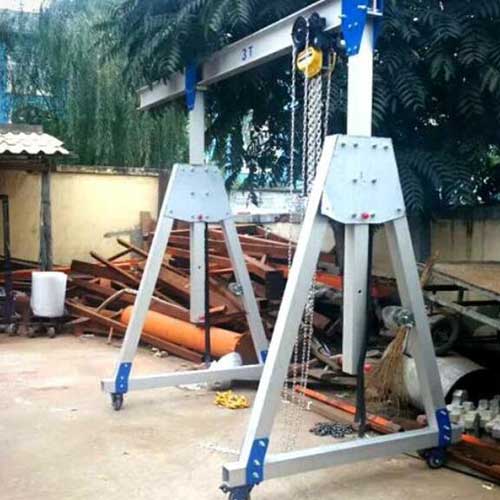
Adjustable Span Aluminum A Frame Cranes:
Design: Adjustable span for customized reach.
Typical Features: Flexible span options for adaptability to varying material dimensions.
Benefits: Versatility in handling materials of different sizes, offering a customizable lifting solution.
Typical Applications: Workspaces with diverse material dimensions and lifting needs.
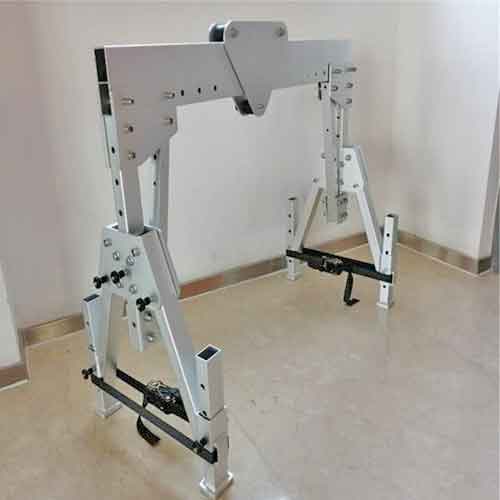
Freestanding Aluminum A Frame Cranes:
Design: Self supporting structure for stability without additional support structures.
Typical Features: No need for additional support structures, ensuring quick setup.
Benefits: Easy to set up and relocate, making it suitable for indoor applications.
Typical Applications: Indoor settings with limited structural support, where quick and independent crane setup is essential.
Ideal Use Cases and Industrial Applications of Portable A Frame Cranes
Portable A Frame Cranes prove indispensable in industries and scenarios where the agility of lifting solutions is paramount. Specifically designed for swift relocation, these cranes excel in various use cases:
- Maintenance and Repair: Agile Relocation: Portable A Frame Cranes offer agility in maintenance and repair tasks, swiftly relocating to different workstations. This enhances productivity by providing on the spot lifting solutions for equipment maintenance.
- Construction Sites: Easy Transportability: The portability of Portable A Frame Cranes makes them invaluable on construction sites. Their ease of transport ensures efficient lifting and positioning of materials at various locations, adapting to dynamic construction needs.
- Event Setup: Flexibility in Logistics: Ideal for temporary installations and events, Portable A Frame Cranes provide flexibility in lifting logistics. Their adaptability and ease of setup contribute to efficient handling of equipment and materials during event construction and breakdown, aligning with changing requirements.
- Warehousing: Dynamic Storage Layouts: In warehousing with dynamic storage configurations, Portable A Frame Cranes facilitate efficient material movement. Their adaptability ensures they can swiftly adjust to ever changing storage layouts, offering a flexible solution for lifting and transporting goods.
- Outdoor Markets and Trade Shows: On Demand Lifting: Specifically suited for outdoor markets and trade shows, Portable A Frame Cranes deliver on demand lifting capabilities. Their portability allows for quick and efficient material handling in diverse outdoor environments.
- Workshops with Limited Space: Space Efficient Solutions: Compact and maneuverable, Portable A Frame Cranes are ideal for workshops with limited space. Their design allows easy movement within confined workshop areas, providing versatile solutions for lifting and positioning tasks.
- Emergency Response: Rapid Deployment: In emergency situations or disaster response scenarios, Portable A Frame Cranes offer a rapid deployment solution for lifting and moving debris, equipment, or materials. Their portability enhances efficiency in emergency response efforts.
- Temporary Manufacturing Sites: On the Go Manufacturing: Designed for scenarios with temporary or changing manufacturing needs, Portable A Frame Cranes offer a mobile lifting solution. They can be swiftly deployed to address varying lifting requirements in temporary manufacturing setups.
In summary, Portable A Frame Cranes are engineered for industries requiring on the go lifting solutions. Their versatility, ease of transport, and adaptability to dynamic environments make them invaluable in various applications, enhancing efficiency and flexibility in material handling processes.
Factors to Consider When Buying A Frame Cranes
Load Capacity
- Understanding Load Requirements When embarking on the journey to procure an A Frame Crane, the first and foremost consideration is comprehending your load requirements. Accurate knowledge of the weight and dimensions of the materials to be lifted is essential. This includes both the maximum load and any potential variations in weight. Analyzing your load requirements ensures that the chosen crane is not only capable of handling the intended materials but also provides a safety margin for unforeseen circumstances.
- Matching Crane Capacity to Application Needs Matching the crane capacity to the specific needs of your application is a critical step in the selection process. It involves aligning the crane's lifting capacity, expressed in tons, with the heaviest load the crane is expected to handle. It's imperative to consider not only the static weight but also any dynamic factors that may impact the load during lifting, such as acceleration and deceleration. Ensuring the crane's capacity exceeds the maximum expected load guarantees safe and efficient material handling operations.
Span and Height
- Determining the Required Span and Lifting Height Span and lifting height are pivotal factors in determining the suitability of an A Frame Crane for your application. Span refers to the distance between the crane's supporting legs, while lifting height pertains to how high the crane needs to lift materials. Accurate measurements of the working area, including the distance materials need to be moved horizontally and vertically, aid in selecting a crane with the appropriate span and lifting height capabilities.
- Customization Options for Specific Workspace Constraints Every workspace comes with its unique set of constraints and challenges. A reputable A Frame Crane provider should offer customization options to tailor the crane to your specific workspace requirements. This may include adjustments to the crane's dimensions, such as reduced span or modified lifting height, ensuring optimal integration within the designated workspace. Customization enhances efficiency and safety by accommodating the nuances of your operating environment.
Hoisting Mechanism
Electric Hoists vs. Manual Hoists for Smal A frame Gantry Cranes
The choice between electric and manual hoists is a crucial decision, impacting both operational efficiency and workforce requirements.
- Electric Hoists: These are powered by electricity and offer precise control over lifting operations. Electric hoists are ideal for applications requiring frequent lifting and precise positioning. They reduce manual effort and enhance overall productivity.
- Manual Hoists: Operated manually by the crane operator, manual hoists are simpler in design and are suitable for lighter lifting tasks. They are cost effective and may be preferred in situations where electricity is not readily available.
The choice between electric hoists and manual hoists for small A Frame Gantry Cranes hinges on various factors, including the nature of the lifting tasks, frequency of use, and the level of precision required. Here's a comparison to help you make an informed decision:
Electric Hoists:
Power Source:
Electrically Powered: Electric hoists are powered by electricity, providing consistent and reliable performance. They offer precise control over lifting and lowering operations.
Benefits:
Efficiency: Electric hoists are efficient for repetitive lifting tasks and applications where speed and precision are crucial.
Reduced Manual Effort: Operators experience less physical strain as the hoist's motorized mechanism performs the lifting.
Applications:
Frequent Use: Ideal for small A Frame Gantry Cranes used frequently throughout the day.
Precision Lifting: Suited for tasks that require precise positioning of loads, making them common in manufacturing and assembly processes.
Considerations:
Power Source Availability: Ensure a reliable power source is readily available in your workspace.
Initial Investment: Electric hoists may have a higher upfront cost, but they often provide long term efficiency benefits.
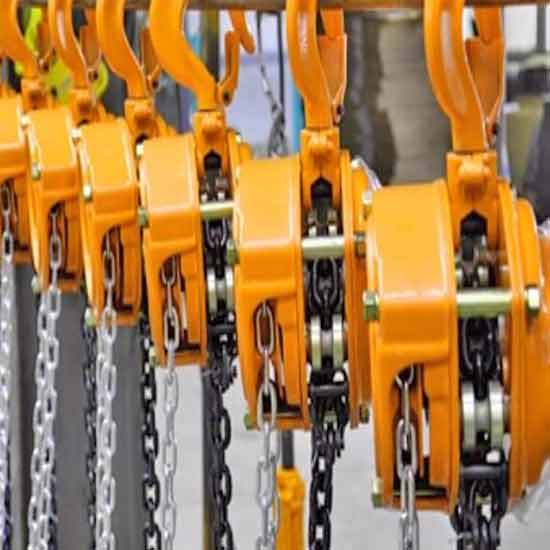
Manual electric chain block
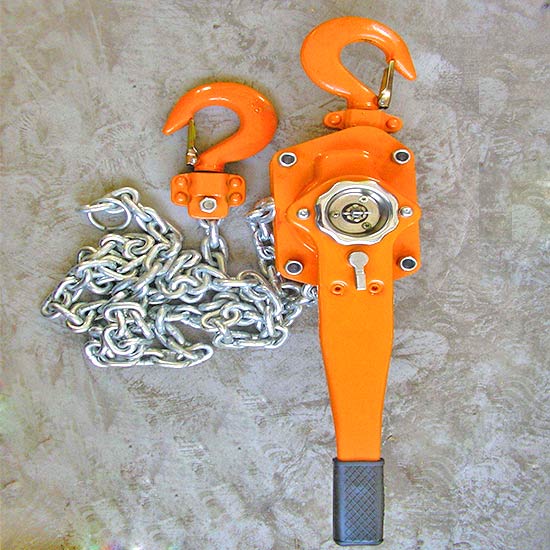
Lever chain hoist
Manual Hoists:
Operation:
Manually Operated: Manual hoists rely on the physical effort of the operator for lifting and lowering loads. They often feature a hand chain or lever mechanism.
Benefits:
Simplicity: Manual hoists are straightforward in design and operation, making them easy to use and maintain.
Cost Effective: Generally more cost effective upfront compared to electric hoists.
Applications:
Intermittent Use: Suitable for small A Frame Gantry Cranes used intermittently or for occasional lifting tasks.
Low to Medium Load Capacity: Commonly used for lighter loads where manual effort is manageable.
Considerations:
Operator Physical Exertion: Manual hoists require more physical effort from the operator, which can be a consideration for prolonged or repetitive tasks.
Limited Speed and Precision: Manual hoists may have limitations in terms of lifting speed and precision compared to electric hoists.
Choosing Between Electric and Manual Hoists:
- Task Frequency: If your small A Frame Gantry Crane will be used frequently for lifting tasks, an electric hoist may provide greater efficiency and speed.
- Load Capacity: Consider the weight of the loads you'll be lifting. Electric hoists are generally better suited for heavier loads, while manual hoists are suitable for lighter applications.
- Operator Preference: Assess the physical capabilities and preferences of the operators. Electric hoists reduce manual effort, promoting operator comfort and minimizing fatigue.
- Budget Constraints: Evaluate your budget constraints, considering both upfront costs and long term operational efficiency. Manual hoists may be a cost effective solution for certain applications.
In summary, the choice between electric hoists and manual hoists for small A Frame Gantry Cranes depends on the specific needs of your lifting tasks, the frequency of use, and the available budget. Carefully weigh the advantages and considerations to determine the most suitable hoist type for your application.
Benefits and Drawbacks of Different Hoisting Mechanisms
Electric Hoists:
Benefits: Precision in lifting and positioning, reduced manual effort, suitable for heavy loads, and increased productivity.
Drawbacks: Initial higher investment, dependence on electricity, and potential maintenance requirements.
Manual Hoists:
Benefits: Cost effective, simplicity in design, and independence from electrical power sources.
Drawbacks: Limited capacity for heavy loads, manual effort required, and reduced speed compared to electric hoists.
Carefully evaluating the specific requirements of your application and considering the trade offs between electric and manual hoisting mechanisms will guide you towards the most suitable choice for your A Frame Crane.
Electric Chain Hoist vs. Electric Wire Rope Hoist for A Frame Gantry Cranes
Choosing between an Electric Chain Hoist and an Electric Wire Rope Hoist is a pivotal decision when configuring A Frame Gantry Cranes. Each hoist type comes with distinct features, advantages, and applications, influencing the overall performance of the crane.
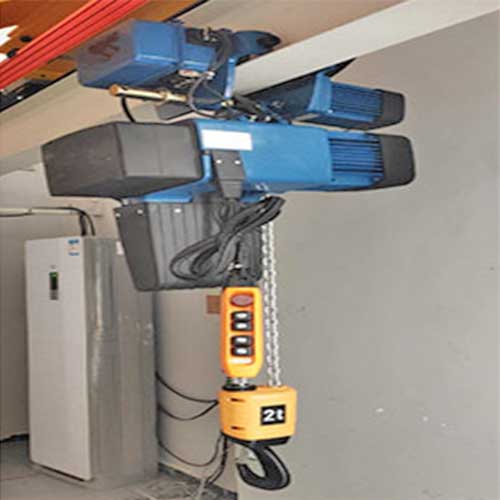
Design and Construction:
Chain Mechanism: Utilizes a chain mechanism for lifting, characterized by a linked chain loop.
Compact Design: Generally more compact and lightweight compared to wire rope hoists, making them suitable for applications with space constraints.
Benefits:
Ease of Maintenance: Electric chain hoists are often simpler in design, facilitating easier maintenance and minimizing downtime.
Precise Control: Offers precise control during lifting and lowering operations, making them suitable for tasks requiring accuracy.
Applications:
Light to Medium Loads: Well suited for lifting light to medium loads in various industries, including manufacturing, workshops, and warehouses.
Limited Vertical Lift Height: Ideal for applications with limited vertical lift height requirements.
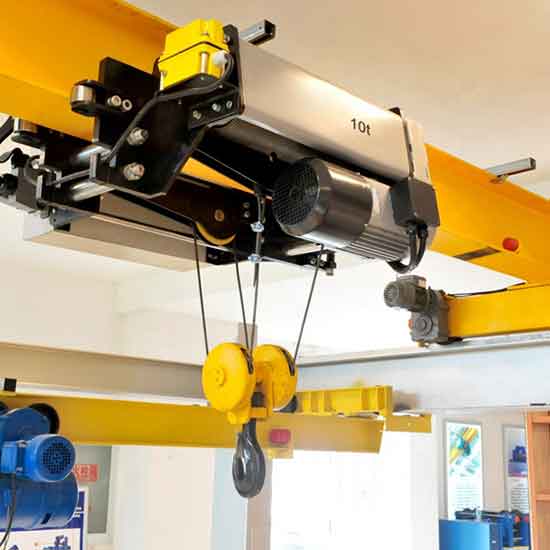
Design and Construction:
Wire Rope Mechanism: Utilizes a wire rope wound around a drum for lifting, providing strength and durability.
Robust Build: Generally designed to handle heavier loads and more demanding lifting tasks.
Benefits:
High Lifting Capacity: Offers higher lifting capacities compared to electric chain hoists, making them suitable for heavy duty applications.
Extended Vertical Lift Height: Well suited for applications requiring extended vertical lift height.
Applications:
Heavy Duty Tasks: Ideal for industries where heavy loads need to be lifted regularly, such as steel fabrication, shipbuilding, and construction.
Greater Vertical Reach: Suitable for applications where materials need to be lifted to greater heights.
Considerations for Decision Making:
- Load Capacity: Assess the weight of materials to be lifted regularly. Electric wire rope hoists are favored for heavy loads, while electric chain hoists are suitable for lighter to medium loads.
- Vertical Lift Height: Consider the vertical lift height required for your application. If you need to lift materials to greater heights, an electric wire rope hoist might be more appropriate.
- Space Constraints: Electric chain hoists, with their compact design, are advantageous in settings with limited space. Evaluate your workspace to determine the most suitable hoist type.
- Maintenance Considerations: If ease of maintenance is a priority and the lifting capacity is within the required range, an electric chain hoist might be a more convenient choice.
Ultimately, the decision between an Electric Chain Hoist and an Electric Wire Rope Hoist should align with the specific lifting needs and operational demands of your A Frame Gantry Crane application. Careful consideration of load requirements, vertical lift height, and space constraints will guide you towards the hoist type that optimally complements your crane setup.
Comparisons: Buying vs. Renting A Frame Cranes
Cost Analysis
- Initial Investment vs. Rental Costs :Making a decision between buying and renting an A Frame Crane involves a thorough cost analysis. The initial investment in purchasing a crane may seem substantial, covering the crane's cost, installation, and any customization required. On the other hand, renting offers a more immediate, albeit ongoing, cost solution, typically comprising rental fees and, in some cases, delivery and setup costs. It's crucial to weigh these upfront and ongoing expenses against the projected frequency and duration of crane usage.
- Long Term Cost Considerations :Beyond the immediate costs, long term considerations play a pivotal role in the decision making process. Owning a crane involves maintenance, repairs, and potential upgrades over time. These costs need to be factored into the overall ownership expense. Renting, while seemingly less expensive upfront, may accumulate higher costs over an extended period. Evaluating the long term cost implications helps in making a financially prudent decision that aligns with your project or business goals.
Customization Options
- Advantages of Buying for Tailored Solutions :One of the significant advantages of buying an A Frame Crane is the ability to tailor the solution to meet specific needs. Purchased cranes can be customized for unique project requirements, including modifications to span, height, hoisting mechanisms, and additional features. Customization ensures that the crane is optimized for your operational environment, enhancing efficiency and safety.
- Limitations of Rental Options :Rental cranes, while offering a quick solution, often come with limitations in terms of customization. Rental companies may have a standardized fleet with limited options for modifications. This can be a drawback when your project demands specific features or configurations. Customization limitations may impact the crane's suitability for complex or specialized tasks.
Project Duration and Frequency
- Assessing the Duration and Frequency of Crane Usage :A critical factor in the buy versus rent decision is the duration and frequency of crane usage. For projects with a consistent need for lifting solutions over an extended period, buying might be a cost effective choice. On the other hand, short term projects or sporadic usage may favor the flexibility and immediate availability offered by renting.
- Applicability of Buying or Renting Based on Project Needs : Understanding the nature of your projects is paramount. Long term projects with steady lifting requirements may warrant the purchase of a crane tailored to your specifications. In contrast, short term or variable projects, where lifting needs may change, could benefit from the flexibility of renting. Assessing project timelines and lifting demands helps align your choice with the dynamic nature of your operations.
By delving into cost considerations, customization options, and project specific factors, you can make an informed decision on whether to buy or rent an A Frame Crane. In the upcoming section, we'll explore the advantages of opting for custom A Frame Cranes tailored to your unique application needs. Stay tuned for Part
Custom A Frame Cranes: Tailoring Solutions to Your Application
Benefits of Custom A Frame Cranes
- Meeting Unique Specifications :The advantages of opting for custom A Frame Cranes are manifold, with the foremost being the ability to meet unique specifications. Every industry and project has distinct requirements, and a custom crane ensures a perfect fit. Whether it's adjusting the crane's span, height, or incorporating specialized features, customization allows you to address specific challenges and optimize the crane for your application's intricacies.
- Enhancing Efficiency and Safety :Custom A Frame Cranes play a pivotal role in enhancing both operational efficiency and workplace safety. By tailoring the crane to the exact needs of your workflow, you can streamline material handling processes, reduce downtime, and improve overall efficiency. Additionally, customization allows for the integration of safety features and protocols, minimizing the risk of accidents and ensuring a secure working environment.
Collaboration with Manufacturers
- Working with Experienced Manufacturers :The key to a successful custom A Frame Crane lies in collaboration with experienced manufacturers. Choose a manufacturer with a proven track record in designing and producing customized lifting solutions. Experienced manufacturers possess the expertise to understand complex project requirements and offer tailored solutions that align with industry standards and regulations.
- Importance of Clear Communication for Customization :Clear and open communication between the purchaser and the manufacturer is paramount for successful customization. Clearly articulate your project specifications, lifting requirements, and any unique challenges your application may present. Establishing a transparent line of communication ensures that the manufacturer fully comprehends your needs, enabling them to design and deliver a custom A Frame Crane that precisely aligns with your expectations.
Tips for a Successful A Frame Crane Purchase
Researching Reputable Suppliers
- Industry Experience and Reputation :When embarking on an A Frame Crane purchase, start by researching and identifying reputable suppliers with significant industry experience. A manufacturer or supplier with a long standing presence in the market often indicates reliability and expertise. Look for testimonials, case studies, and customer feedback to gauge the reputation of potential suppliers.
- Product Range and Specialization :Consider suppliers who specialize in A Frame Cranes and offer a diverse product range. A company dedicated to manufacturing lifting solutions is likely to have a deeper understanding of the nuances involved, providing you with a broader spectrum of options to choose from.
Seeking References and Reviews
- Customer References :Requesting customer references from potential suppliers allows you to gain insights into their track record. Reach out to previous clients who have purchased A Frame Cranes from the supplier to gather firsthand information about their experiences. Understanding how well the supplier delivered on promises and handled challenges is invaluable in making an informed decision.
- Online Reviews and Testimonials :In the digital age, online reviews and testimonials are valuable resources for gauging customer satisfaction. Explore various platforms to gather reviews about the supplier's products and services. Pay attention to both positive and negative feedback, and consider how the supplier addresses concerns or issues raised by customers.
Inspection and Testing
- On Site Visits :Whenever feasible, conduct on site visits to the manufacturing facilities of potential suppliers. This provides an opportunity to assess the quality of materials used, the manufacturing processes, and the overall production environment. Witnessing the manufacturing process firsthand helps in building confidence in the supplier's capabilities.
- Product Testing and Demonstrations :Request product demonstrations and testing opportunities. A reputable supplier should be willing to showcase their A Frame Cranes, allowing you to observe their performance and assess their features. Testing also provides a practical understanding of how well the crane meets your specific requirements.
Warranty and After Sales Support
- Warranty Coverage :Carefully review the warranty terms offered by the supplier. A comprehensive warranty reflects the manufacturer's confidence in the quality of their A Frame Cranes. Pay attention to the duration of the warranty and the coverage it provides for various components. A clear and detailed warranty is crucial for long term peace of mind.
- After Sales Support Consider the after sales support provided by the supplier. A reliable supplier should offer ongoing support, including maintenance services, spare parts availability, and technical assistance. A robust after sales support system ensures that your A Frame Crane continues to operate at optimal levels throughout its lifecycle.
Wrap it up, Get Your Custom A Frame Crane Design
In our comprehensive guide on A Frame Cranes, we've covered a diverse range of topics to equip you with the knowledge needed for a successful purchase. Let's recap the key points:
- Introduction to A Frame Cranes: Explored the basics and importance of selecting the right A Frame Crane for specific applications.
- Types of A Frame Cranes for Sale: Detailed insights into Single Girder, Double Girder, and Single Leg A Frame Cranes, providing a comprehensive understanding of their features and applications.
- Portable A Frame Cranes: Explored the mobility and adaptability features, along with various types of steel and aluminum portable cranes.
- Factors to Consider When Buying A Frame Cranes: Delved into load capacity, span and height, and hoisting mechanisms, providing a guide for making informed decisions.
- Comparisons: Buying vs. Renting A Frame Cranes: Explored the cost analysis, customization options, and considerations based on project duration and frequency.
- Custom A Frame Cranes: Highlighted the benefits of tailoring solutions to specific applications and the importance of collaboration with experienced manufacturers.
- Tips for a Successful A Frame Crane Purchase: Provided insights into researching reputable suppliers, seeking references and reviews, inspection and testing, and the significance of warranty and after sales support.
Selecting the right A Frame Crane is not just a one time decision; it's an investment in long term success. The crane you choose plays a pivotal role in the efficiency, safety, and overall productivity of your material handling operations. By understanding your unique requirements and making informed decisions, you set the foundation for sustained success.
Every application is unique, and the success of your material handling operations hinges on choosing the A Frame Crane that aligns seamlessly with your specific needs. We encourage readers to leverage the knowledge gained from this guide to make informed decisions. Consider the nuances of your projects, the intricacies of your workspace, and the long term goals of your operations. Tailoring your choice to these factors ensures that your A Frame Crane becomes a strategic asset, contributing to the growth and efficiency of your business.
In conclusion, the world of A Frame Cranes is vast and diverse, offering solutions for a myriad of lifting challenges. We hope this guide has empowered you with the insights needed to navigate this landscape and make decisions that lead to success. Whether you are acquiring a single girder crane for a workshop or investing in a custom solution for a complex project, may your A Frame Crane choice elevate your material handling capabilities and contribute to the prosperity of your endeavors.
Main Projects
Related Products

Supplied three grab bucket crane kits to Indonesia, enhancing garbage handling efficiency with high load capacity and reliable performance.
Free consultation to Confirm Parameters & Specifications and Get
Latest Crane Price & Crane Rate.
- Types of overhead cranes : _______?
- Optional: Overhead travelling crane, goliath gantry crane,Slewing jib crane, Single girder or double girder crane,small portable crane or kbk crane, etc.
- Capacity of overhead crane: _______?
- Optional: 0.25ton, 0.5 ton, 1 ton, 2 ton, 3ton, 5 ton, 10 ton,15ton, 20ton, 25 ton, 30ton,35ton, up to 550ton, etc.
- Crane span & lifting height : _______?
- Crane travelling length : _____?
- Control of overhead crane:_______?
- Optional: pendant/ remote/cabin control
- Voltage supply of overhead crane:_____?
- Eg,: 380V50/60HZ,3Phase or others,etc.
- Application/usage of crane:_______?
- Eg,: Steel mill, ,injection mold, cement,stone, concrete,granite, general manufacturing, etc.
Just leave a message via the contact form and our hoist and crane engineer will contact you with in 24working hours.
Get In Touch
